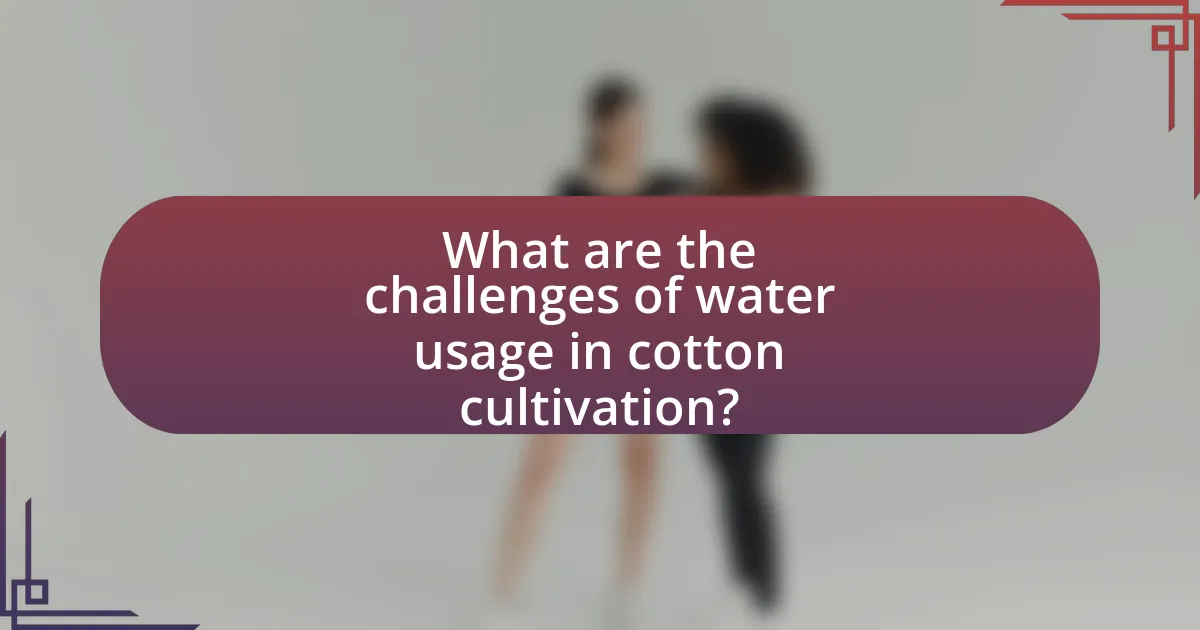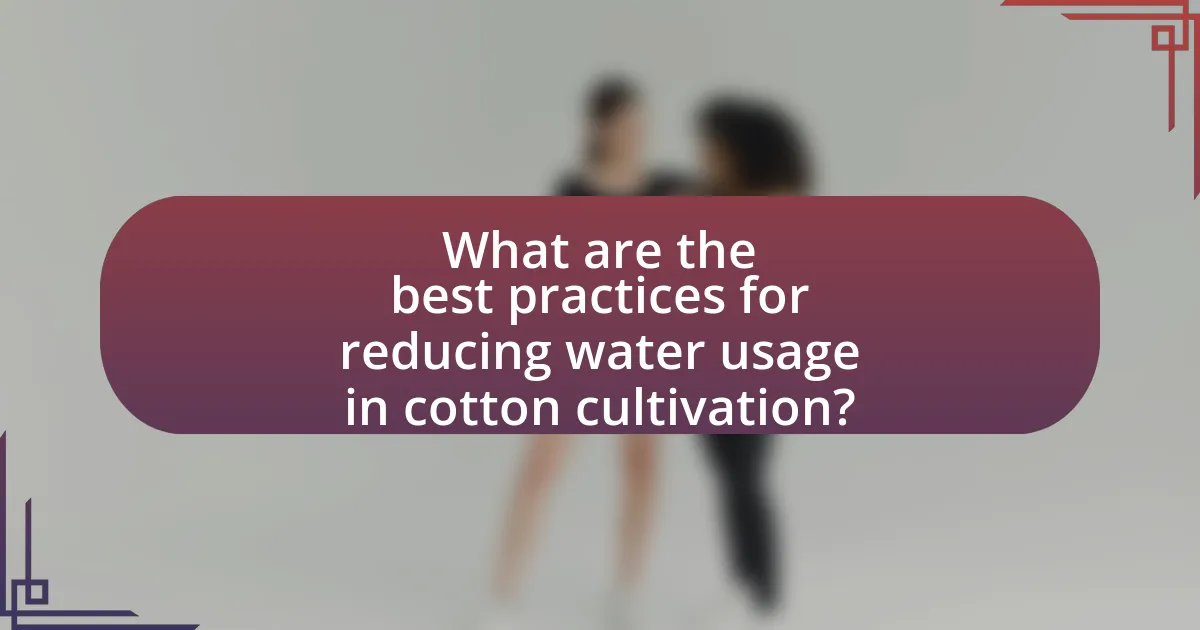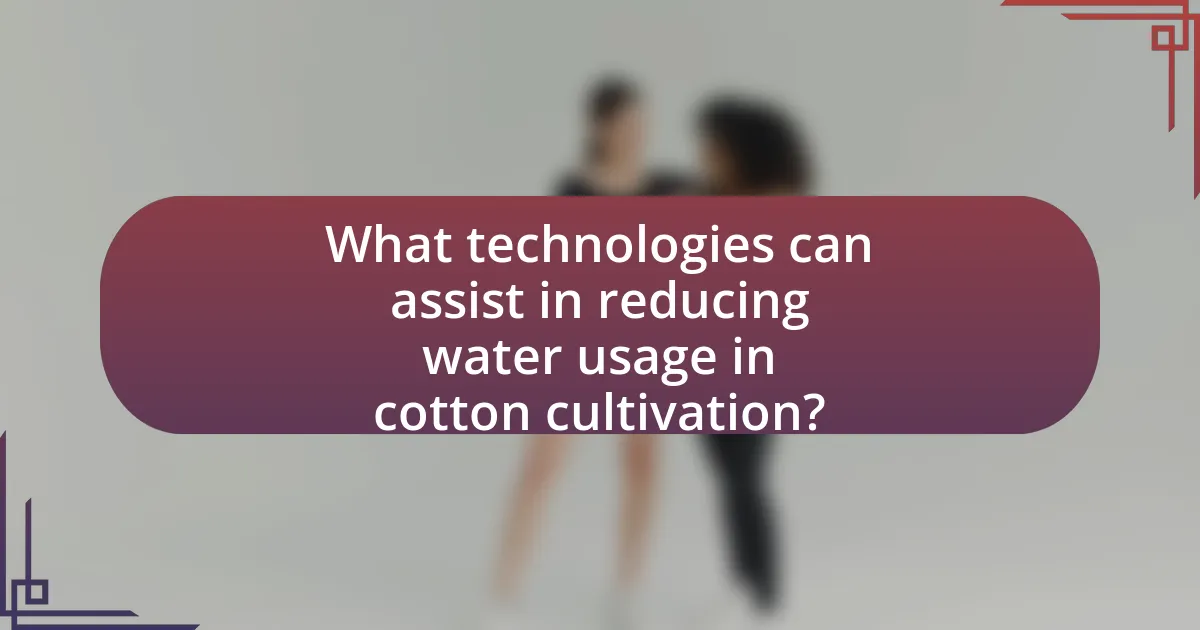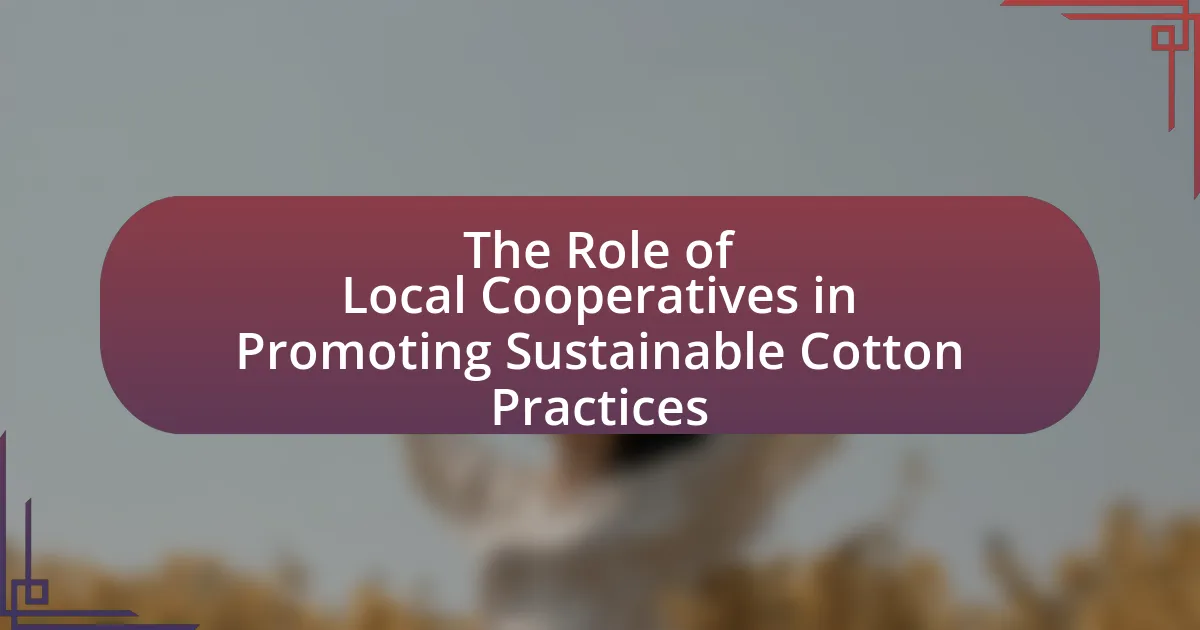The article focuses on reducing water usage in cotton cultivation, highlighting the significant challenges posed by high water demand, inefficient irrigation practices, and climate variability. It discusses the negative impacts of excessive water usage, including soil salinization and reduced crop yields, while emphasizing the environmental consequences such as depletion of freshwater resources. Key strategies for water conservation are outlined, including the adoption of efficient irrigation methods like drip irrigation, soil moisture monitoring, and the use of drought-resistant cotton varieties. Additionally, the article explores the role of soil management techniques and emerging technologies in optimizing water use, ultimately promoting sustainable agricultural practices in cotton farming.

What are the challenges of water usage in cotton cultivation?
The challenges of water usage in cotton cultivation include high water demand, inefficient irrigation practices, and climate variability. Cotton requires approximately 7,000 to 29,000 liters of water per kilogram of fiber produced, leading to significant water consumption. Inefficient irrigation methods, such as flood irrigation, can result in water wastage, with studies indicating that up to 50% of water can be lost through evaporation and runoff. Additionally, climate variability, including droughts and changing precipitation patterns, exacerbates water scarcity, making it difficult for farmers to maintain adequate water supply for cotton crops. These factors collectively hinder sustainable water management in cotton cultivation.
How does excessive water usage impact cotton farming?
Excessive water usage negatively impacts cotton farming by leading to soil salinization, reduced crop yields, and increased production costs. When cotton plants receive more water than necessary, it can cause salts in the soil to accumulate, which adversely affects plant growth and health. Research indicates that over-irrigation can reduce cotton yields by as much as 20% due to the detrimental effects of salinity on root development and nutrient uptake. Additionally, excessive water usage increases the cost of irrigation systems and energy consumption, further straining the economic viability of cotton farming.
What are the environmental consequences of high water consumption in cotton cultivation?
High water consumption in cotton cultivation leads to significant environmental consequences, including depletion of freshwater resources, soil degradation, and increased salinity. The excessive withdrawal of water from rivers and aquifers for irrigation can result in reduced water availability for other ecosystems and communities, threatening biodiversity. Additionally, the overuse of water can cause soil erosion and nutrient depletion, negatively impacting soil health and agricultural productivity. Furthermore, high water usage can lead to salinization, where salts accumulate in the soil, making it less fertile and reducing crop yields. According to the Food and Agriculture Organization, cotton cultivation is one of the most water-intensive crops, requiring approximately 7,000 to 29,000 liters of water per kilogram of cotton produced, which underscores the urgency of addressing water consumption in this sector.
How does water scarcity affect cotton yield and quality?
Water scarcity significantly reduces cotton yield and quality. When cotton plants experience insufficient water, their growth is stunted, leading to lower biomass production and reduced fiber length. Research indicates that a 20% reduction in water availability can decrease cotton yield by up to 50%, as evidenced by studies conducted in arid regions where irrigation is limited. Additionally, water stress negatively impacts fiber quality, resulting in shorter, weaker fibers that are less desirable in the textile market. This correlation between water scarcity and diminished yield and quality underscores the critical need for effective water management practices in cotton cultivation.
Why is it important to reduce water usage in cotton cultivation?
Reducing water usage in cotton cultivation is crucial to conserve water resources and enhance sustainability. Cotton is a water-intensive crop, requiring approximately 7,000 to 29,000 liters of water to produce just one kilogram of cotton, depending on the region and farming practices. By minimizing water consumption, farmers can mitigate the strain on local water supplies, especially in arid regions where water scarcity is a pressing issue. Additionally, reducing water usage can lead to lower production costs and improved crop resilience, ultimately supporting environmental health and agricultural productivity.
What benefits does water conservation bring to cotton farmers?
Water conservation provides significant benefits to cotton farmers by enhancing crop yield and reducing production costs. Efficient water management practices can lead to improved soil health, which in turn supports better cotton growth. For instance, studies have shown that implementing drip irrigation systems can reduce water usage by up to 60% while increasing cotton yields by 20-30%. Additionally, conserving water helps mitigate the risks associated with drought, ensuring that farmers maintain consistent production levels even during dry spells. This not only secures their income but also contributes to sustainable agricultural practices, promoting long-term viability in cotton farming.
How does reducing water usage contribute to sustainable agriculture?
Reducing water usage contributes to sustainable agriculture by enhancing resource efficiency and minimizing environmental impact. Efficient water management practices, such as drip irrigation and rainwater harvesting, can significantly lower water consumption while maintaining crop yields. For instance, studies have shown that implementing drip irrigation can reduce water usage by up to 60% compared to traditional methods, leading to less water wastage and improved soil health. Furthermore, reduced water usage helps preserve local water sources, ensuring their availability for future agricultural needs and supporting biodiversity in surrounding ecosystems.

What are the best practices for reducing water usage in cotton cultivation?
The best practices for reducing water usage in cotton cultivation include implementing drip irrigation, utilizing soil moisture sensors, adopting drought-resistant cotton varieties, and practicing crop rotation. Drip irrigation delivers water directly to the plant roots, minimizing evaporation and runoff, which can reduce water usage by up to 50% compared to traditional methods. Soil moisture sensors provide real-time data on soil water levels, allowing farmers to irrigate only when necessary, further conserving water. Drought-resistant cotton varieties are engineered to thrive with less water, which can significantly decrease irrigation needs. Additionally, crop rotation can improve soil health and moisture retention, leading to more efficient water use in subsequent cotton crops. These practices collectively contribute to sustainable water management in cotton farming.
How can soil management techniques help in conserving water?
Soil management techniques can significantly help in conserving water by improving soil structure and enhancing its water retention capacity. Practices such as mulching, cover cropping, and reduced tillage create a protective layer on the soil surface, which minimizes evaporation and promotes moisture retention. For instance, studies have shown that mulching can reduce soil temperature and evaporation rates by up to 50%, thereby conserving water. Additionally, cover crops improve soil organic matter, which increases the soil’s ability to hold water, leading to better moisture availability for cotton plants. These techniques not only optimize water usage but also enhance soil health, contributing to sustainable cotton cultivation.
What role does soil health play in water retention?
Soil health significantly enhances water retention by improving soil structure, increasing organic matter, and promoting beneficial microbial activity. Healthy soils with good structure allow for better infiltration and retention of water, reducing runoff and evaporation. Research indicates that soils rich in organic matter can hold up to 20 times their weight in water, which is crucial for crops like cotton that require consistent moisture. Additionally, healthy soils support diverse microbial communities that contribute to nutrient cycling and soil aggregation, further enhancing water retention capabilities.
How can cover cropping improve soil moisture levels?
Cover cropping improves soil moisture levels by enhancing soil structure and increasing organic matter content. The roots of cover crops create channels in the soil, allowing for better water infiltration and retention. Additionally, cover crops reduce evaporation by providing ground cover, which protects the soil surface from direct sunlight and wind. Research indicates that fields with cover crops can retain up to 25% more moisture compared to bare soil, demonstrating their effectiveness in maintaining soil moisture levels.
What irrigation methods are most effective for water conservation?
Drip irrigation is the most effective method for water conservation in agriculture, particularly in cotton cultivation. This technique delivers water directly to the plant roots through a network of tubing and emitters, minimizing evaporation and runoff. Studies have shown that drip irrigation can reduce water usage by up to 60% compared to traditional surface irrigation methods. Additionally, it promotes healthier plant growth by providing consistent moisture levels, which is crucial for cotton crops.
How does drip irrigation compare to traditional methods?
Drip irrigation is more efficient than traditional irrigation methods, as it delivers water directly to the plant roots, minimizing evaporation and runoff. Studies show that drip irrigation can reduce water usage by 30-50% compared to surface irrigation methods, which often waste water through evaporation and deep percolation. Additionally, research published in the Journal of Irrigation and Drainage Engineering indicates that drip irrigation can increase crop yields by 20-90% due to improved water availability and nutrient uptake.
What are the advantages of using rain-fed irrigation systems?
Rain-fed irrigation systems offer several advantages, particularly in reducing water usage for cotton cultivation. These systems rely on natural rainfall, minimizing the need for additional water sources, which can lead to lower operational costs and reduced energy consumption associated with pumping water. Furthermore, rain-fed systems promote sustainable agricultural practices by enhancing soil moisture retention and reducing soil erosion, as observed in various studies. For instance, research indicates that rain-fed agriculture can improve crop resilience to drought conditions, ultimately leading to better yields in regions where water scarcity is a concern.
How can crop selection and rotation influence water usage?
Crop selection and rotation significantly influence water usage by optimizing soil moisture retention and reducing irrigation needs. For instance, selecting drought-resistant crops or those with lower water requirements can lead to decreased overall water consumption. Additionally, rotating crops can improve soil health and structure, enhancing its ability to retain moisture. Research indicates that implementing crop rotation can reduce water usage by up to 30% in certain agricultural systems, as diverse root structures help in better water absorption and utilization. This practice not only conserves water but also promotes sustainable farming by minimizing the risk of soil degradation.
What cotton varieties are more drought-resistant?
Drought-resistant cotton varieties include Deltapine 1646 B2RF, Phytogen 499 WRF, and Stoneville 474. These varieties have been specifically bred to withstand water scarcity, exhibiting traits such as deep root systems and improved water-use efficiency. Research indicates that Deltapine 1646 B2RF can yield up to 20% more under drought conditions compared to traditional varieties, while Phytogen 499 WRF has shown resilience in arid environments, making it a preferred choice for regions facing water shortages.
How does crop rotation affect water efficiency in cotton farming?
Crop rotation enhances water efficiency in cotton farming by improving soil structure and moisture retention. When different crops are planted in succession, the diverse root systems help break up compacted soil, allowing for better water infiltration and reducing runoff. Research indicates that rotating cotton with legumes can increase soil organic matter, which further enhances the soil’s ability to retain moisture. For instance, a study published in the “Agricultural Water Management” journal found that fields with a rotation of cotton and legumes showed a 20% increase in water retention compared to continuous cotton cropping. This practice not only conserves water but also promotes healthier crop yields.

What technologies can assist in reducing water usage in cotton cultivation?
Technologies that can assist in reducing water usage in cotton cultivation include drip irrigation, soil moisture sensors, and drought-resistant cotton varieties. Drip irrigation delivers water directly to the plant roots, minimizing evaporation and runoff, which can reduce water usage by up to 50% compared to traditional irrigation methods. Soil moisture sensors provide real-time data on soil moisture levels, allowing farmers to irrigate only when necessary, further conserving water. Drought-resistant cotton varieties are genetically engineered to require less water while maintaining yield, thus contributing to overall water savings in cotton farming.
How can precision agriculture tools optimize water use?
Precision agriculture tools optimize water use by employing technologies such as soil moisture sensors, satellite imagery, and variable rate irrigation systems. These tools provide real-time data on soil conditions and crop needs, allowing farmers to apply water more efficiently and only when necessary. For instance, soil moisture sensors can detect moisture levels at various depths, enabling targeted irrigation that reduces water waste. Studies have shown that implementing precision irrigation can lead to water savings of up to 30% while maintaining crop yields, demonstrating the effectiveness of these tools in enhancing water management in agriculture.
What role do soil moisture sensors play in irrigation management?
Soil moisture sensors play a critical role in irrigation management by providing real-time data on soil moisture levels, which helps optimize water usage. These sensors enable farmers to make informed decisions about when and how much to irrigate, reducing water waste and ensuring that crops receive adequate moisture. Research indicates that using soil moisture sensors can lead to a 20-50% reduction in irrigation water use, as they allow for precise scheduling based on actual soil conditions rather than relying on fixed schedules or weather forecasts. This data-driven approach not only conserves water but also enhances crop yield and health, making it an essential tool in sustainable cotton cultivation practices.
How can data analytics improve water conservation strategies?
Data analytics can significantly enhance water conservation strategies by enabling precise monitoring and management of water usage in agricultural practices, particularly in cotton cultivation. By analyzing data from various sources such as soil moisture sensors, weather forecasts, and historical irrigation patterns, farmers can optimize irrigation schedules and reduce water waste. For instance, a study by the University of California found that using data analytics in irrigation management can lead to a 20-30% reduction in water usage while maintaining crop yields. This data-driven approach allows for targeted interventions, ensuring that water is applied only when and where it is needed, thereby promoting sustainable water use in cotton farming.
What innovations are emerging in water-saving technologies for cotton farming?
Emerging innovations in water-saving technologies for cotton farming include precision irrigation systems, drought-resistant cotton varieties, and soil moisture sensors. Precision irrigation systems, such as drip irrigation, deliver water directly to the plant roots, significantly reducing water waste and improving efficiency. Drought-resistant cotton varieties have been developed through genetic engineering and traditional breeding, allowing crops to thrive with less water. Soil moisture sensors provide real-time data on soil conditions, enabling farmers to optimize irrigation schedules and reduce unnecessary water application. These technologies collectively contribute to more sustainable cotton farming practices, addressing the increasing challenges of water scarcity in agriculture.
How do automated irrigation systems enhance water efficiency?
Automated irrigation systems enhance water efficiency by delivering precise amounts of water directly to the root zones of plants, minimizing waste. These systems utilize sensors and timers to monitor soil moisture levels and weather conditions, ensuring that irrigation occurs only when necessary. Research indicates that implementing automated irrigation can reduce water usage by up to 30% compared to traditional methods, as evidenced by studies conducted in various agricultural settings. This targeted approach not only conserves water but also promotes healthier crop growth, particularly in water-intensive crops like cotton.
What are the latest advancements in drought-resistant cotton breeding?
Recent advancements in drought-resistant cotton breeding include the development of genetically modified varieties that enhance water-use efficiency and stress tolerance. For instance, researchers have successfully introduced genes associated with drought resistance, such as the DREB (Dehydration-Responsive Element Binding) transcription factors, into cotton plants, resulting in improved yield under water-limited conditions. A study published in the journal “Plant Biotechnology Journal” by Zhang et al. (2023) demonstrated that these genetically modified cotton varieties exhibited a 30% increase in yield compared to conventional strains during drought conditions. Additionally, marker-assisted selection techniques are being utilized to identify and propagate traits linked to drought resistance more effectively, further accelerating the breeding process.
What practical tips can farmers implement to reduce water usage in cotton cultivation?
Farmers can implement several practical tips to reduce water usage in cotton cultivation, including adopting drip irrigation systems, which deliver water directly to the plant roots, minimizing evaporation and runoff. Research indicates that drip irrigation can reduce water usage by up to 50% compared to traditional methods. Additionally, farmers should practice soil moisture monitoring to optimize irrigation schedules, ensuring water is applied only when necessary. Implementing cover crops can improve soil health and moisture retention, further decreasing the need for irrigation. Lastly, selecting drought-resistant cotton varieties can significantly lower water requirements, as these plants are bred to thrive in arid conditions.





